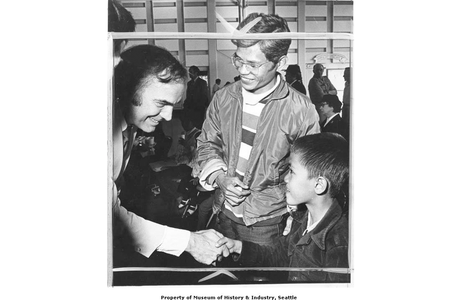It's almost an American birthright: the lure of the open road, the siren song of travel, the sheer visceral excitement of a road trip. In fact, the glamor is overrated. Highways are crowded and gas is expensive. Bus stations long ago became a dumping ground for the down and out. Airports teem with long lines and short-tempered travelers.
Trains, once the most elegant form of travel, have fallen victim to erratic schedules and outdated equipment, not to mention decaying terminals in many cities. For a long while, Seattle has been one of them. Had you been sitting on a torn plastic-leather seat in the once-grand waiting room of the King Street Station a few short years ago — stale air, fluorescent lights, a dingy low ceiling, grimy floors, metal gates barring the restrooms — you could easily imagine Charon coming through the flickering gloom to take you across the Styx.
And yet, King Street Station was once among the finest in the land. It was built shortly after the turn of the 20th century, in the heyday of rail travel, and went into service in 1906 as a terminal for the Great Northern and the Northern Pacific railroads. (Union Station, across 5th Avenue to the east, would follow five years later.)
The station's 245-foot clock tower was modeled on the Campanile standing in the Piazza San Marco in Venice. San Marco's tower is 324 feet, same as the Daniels & Fisher tower in Denver, same as Brisbane City Hall. Until the construction of the Smith Tower in 1914, it was the tallest structure in Seattle.

King Street with San Marco campanile. Photo: Ronald Holden.
For a time, its capacity was tested by heavy use, until “glamorous” travel by private automobile in the 1920s outstripped rail. After a brief revival during World War II, King Street fell into disrepair, followed by decades of outright neglect that turned the station into an urban wasteland.
A series of misguided "renovations" in the 1940s, 50s and 60s removed the building's marble walls and glass mosaic tiles; the plaster ceiling was lowered and covered with acoustic tiles. The waiting room's historic light fixtures were replaced with fluorescents, and the elegant terrazzo floor was allowed to crack beyond repair.
Despite the station's deteriorated state, Amtrak began operating increasingly popular trains along the Vancouver-Portland corridor. The trains were clunky and its schedules less than trustworthy. King Street's ticketing facilities and waiting room remained desultory at best, but ridership — and interest — began to pick up and so did interest in a better station. Sounder trains discharged more and more commuters at King Street, where the bus tunnel's Chinatown/International District station provided a seamless connection with Seattle's transit network.
Meantime, Paul Allen bought and renovated Union Station, and the splendors of early 20th century public buildings became apparent. Almost too late, Seattle realized what was being lost.
In 2008, the City of Seattle purchased the station from BNSF, which had taken over local railroad operations, for $10. Using funds from its Bridge-the-Gap levy, Seattle embarked on an ambitious updating. Most of the money went for earthquake protection; another $20 million paid for two new tracks that will make it easier for trains to use the station, rather than backing in and out of the mile-long rail tunnel that runs from the station to the Seattle waterfront.
The centerpiece of the restoration is the “new” waiting room, resurfaced with steel plating and re-plastered (with modern materials such as epoxy molds) to recreate the opulence of the 1916 original. The headline in the Stranger's blog, only slightly overblown: “The New King Street Station Waiting Room Looks Like the Inside of Wedding Cake.”

Ceiling at King Street. Photo: Ronald Holden.
On the outside, a cluster of incongruous microwave dishes and cellular antennas have been removed from the clock tower, and the clock itself has been restored to working order. There's a spiffy new plaza on Jackson that will once again become the station's logical front door, and there are “plans” to put a restaurant into the mezzanine overlooking the plaza with a terrific view north over downtown.
Mayor Mike McGinn and a phalanx of local transportation and preservation officials were on hand Wednesday to inaugurate the new waiting room.

Hizzoner speaks. Photo: Ronald Holden.
Also on hand to celebrate was the Ballard Sedentary Sousa Band, which tootled marches and fanfares from railroad's Golden Age.

The Sousa band. Photo: Ronald Holden.
It was a reminder that over 40 percent of the commuters arrive in Seattle using public transportation these days. King Street is part of the largest transit hub (bus tunnel, Metro, Sounder, Amtrak, the new First Hill streetcar) west of Chicago and north of San Francisco.
It's high time that the space once again celebrates the grandeur of the city's limitless ambition.


